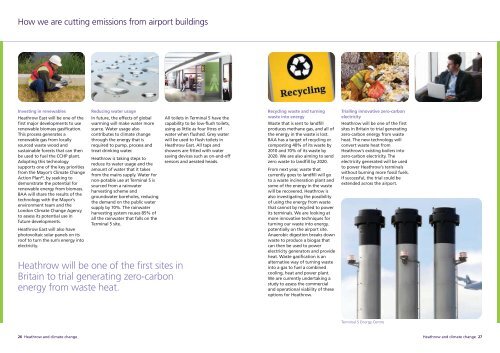Heathrow Airport's emissions reductions efforts - Airports Council ...
Heathrow Airport's emissions reductions efforts - Airports Council ...
Heathrow Airport's emissions reductions efforts - Airports Council ...
You also want an ePaper? Increase the reach of your titles
YUMPU automatically turns print PDFs into web optimized ePapers that Google loves.
Aviation’s contribution to climate changeContrails and cloudsAviation’s contribution toclimate change is growing.Airport sources of carbondioxide <strong>emissions</strong>The impact of clouds on globalclimate change is one of themost uncertain areas ofclimate change science. It isthought that most types ofclouds exert a cooling effecton the Earth’s surface as theyscreen out sunlight.However, the same may not betrue for cirrus clouds - the highthin clouds that could be partlyformed by aircraft contrails.That’s because cirrus cloudsmay allow sunlight through tothe Earth and yet still trapinfrared radiation emitted fromthe Earth.The science is furthercomplicated by whether it isday or night which seems tohave a significant effect onwhether cirrus clouds have awarming or cooling effect.Scientists tend to believe thatcirrus clouds have an overallwarming effect.A special report by the IPCC in1999 estimated that the globalwarming effect of contrailsand other exhaust generatedclouds is only about 1-3% aslarge as the global warmingeffect from all humanproduced greenhouse gases. 36The future climate changecontribution of any industrydepends on several unknownfactors: the industry’s rate ofgrowth; the extent to whichtechnological improvements orenvironmental demandmanagement reduce <strong>emissions</strong>;and the extent to which otherindustries reduce or increase theirown <strong>emissions</strong>. Although wecan’t be sure of aviation’s exact<strong>emissions</strong> in the future we doknow that they are predictedto grow.The Department for Transport’scentral case estimate is thataviation will contribute 21% ofthe UK’s CO2 <strong>emissions</strong> in 2050.This figure also assumes that therest of the economy achieves a60% cut in <strong>emissions</strong>. 37At a global level, the IPCC centralcase estimate is that aviation willaccount for 5% of the world’stotal human contribution toclimate change in 2050 (includingaviation’s non-CO2 impacts),though their estimates rangefrom 3.5% to 15%. 38It is often incorrectly said thataviation is the fastest growingsource of global <strong>emissions</strong>. Infact, a quarter of all globalgreenhouse gas <strong>emissions</strong> comefrom power stations and this hasboth been the fastest growingsource of <strong>emissions</strong> in recentyears and is predicted to growmore than threefold by 2050. 39One of the highest estimates foraviation’s future <strong>emissions</strong> growthis from the Tyndall Centre forClimate Change in a reportcommissioned by Friends of theEarth. 40 It predicts that aviationcould account for all of the UK’spermitted <strong>emissions</strong> by 2050.This forecast is based on veryhigh predictions of passengernumbers which we believe areunrealistic – 1.2 billion passengerjourneys a year, which is nearly2.5 times what the Governmentor other industry forecastersexpect. Some of the TyndallCentre’s forecasts are also basedon the UK achieving larger totalCO2 <strong>reductions</strong> than currentpolicy is targeting.Although the precise futuregreenhouse gas <strong>emissions</strong> fromaviation are uncertain, BAA’sstarting point is simple. Aviation’scontribution is growing and wemust take action now to curb<strong>emissions</strong> from flights.There are several ways in whichairports contribute to greenhousegases which cause climate change:• aircraft <strong>emissions</strong> on theground• passengers and stafftravelling to and from<strong>Heathrow</strong> by road or rail• vehicles on the airfield orvehicles making deliveries tothe airport• energy used by airportbuildings• waste from the airport whichproduces greenhouse gasesthrough disposal• water usageWe are currently undertakingdetailed work to understand theproportion of our <strong>emissions</strong> fromeach of these sources and thetotal non-flight carbon footprintof <strong>Heathrow</strong>.We have a good understandingof the direct carbon dioxideimpacts of the airport, forexample, our energy use in theterminals, but further work needsto be undertaken on morecomplex impacts such aspassenger journeys to the airport.What is the IPCC?Recognizing the problem of potential global climate change, the WorldMeteorological Organization (WMO) and the United NationsEnvironment Programme (UNEP) established the IntergovernmentalPanel on Climate Change (IPCC) in 1988. It is open to all members ofthe UN and WMO.The role of the IPCC is to assess on a comprehensive, objective, openand transparent basis the scientific, technical and socio-economicinformation relevant to understanding the scientific basis of risk ofhuman-induced climate change, its potential impacts and options foradaptation and mitigation. The IPCC does not carry out research nordoes it monitor climate related data. It bases its assessment onthousands of peer reviewed and published scientific or technicalliterature.There are many voices claiming to be the authority on climate change.BAA relies primarily on the work of the IPCC to assess aviation’s currentand future contribution to climate change.The IPCC’s fourth assessment report is based on the work of over 2,500scientific expert reviewers, and more than 800 contributing authorsfrom over 130 countries. It took six years to produce and comprises fourvolumes of work. It is the most authoritative source of advice on globalclimate change available to policymakers.14 <strong>Heathrow</strong> and climate change<strong>Heathrow</strong> and climate change 15

















